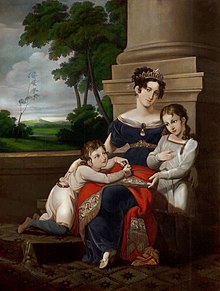Luise of Saxe-Gotha-Altenburg (1800–1831)

Luise, Princess of Saxony-Gotha-Altenburg (full name: Princess Luise Pauline Charlotte Friederike Auguste of Saxony-Gotha-Altenburg , * December 21, 1800 in Gotha ; † August 30, 1831 in Paris ) was a Duchess of Saxony by marriage. Coburg-Saalfeld . As the mother of Prince Albert of Saxe-Coburg-Gotha , she is the direct ancestor of the British royal family .
Life
Luise was born as the only daughter of Duke August von Sachsen-Gotha-Altenburg and his first wife Luise Charlotte zu Mecklenburg on December 21, 1800 at 12:45 p.m. in Friedenstein Castle . She lost her mother shortly after she was born and grew up in Gotha at the court of her father and his second wife Karoline Amalie von Hessen-Kassel . The engagement to the then Duke Ernst I of Saxe-Coburg-Saalfeld took place on December 20 , 1817 the wedding followed in Schloss Friedenstein at the age of 16 with Ernst, who was almost 17 years older. Their marriage, which was obviously arranged for political reasons, began to run into crisis after the birth of their first son Ernst. A year later their second son Albert was born. The couple grew apart. Ernst had several mistresses and Luise had a relationship with the chamberlain Gottfried von Bülow in 1823 and a liaison with the traveling stable master Maximilian Alexander von Hanstein in the summer of 1824 . It finally came to the separation from her husband, which led to some unrest in the Coburg population. In the separation contract, Luise was assigned a castle in Altenburg.
After her father, Duke August, died in 1822, she waived her further claims. Their property rights passed to the sons. On September 2, 1824, Luise had to leave Coburg at midnight without her two sons. Her new place of residence was St. Wendel in the Principality of Lichtenberg , which Duke Ernst had received in the final act of the Congress of Vienna in 1815 due to his services in the battles against Napoleon. However, she suffered greatly from the separation from her two sons. She was denied pictures of the children and permission to visit. Luise's lover, Baron Alexander von Hanstein moved to St. Wendel with her. The divorce against her will followed on March 31, 1826, but she continued to call herself Luise Duchess of Saxony.
Alexander von Hanstein was appointed Count of Pölzig and Beiersdorf by Duke Friedrich von Sachsen-Altenburg on July 19, 1826 , after her property in the Altenburger Land, in order to create the professional requirements for a marriage with Luise . Luise and Alexander married on October 18, 1826 and lived in St. Wendel until February 1831. Luise took a great part in social life and was venerated in the principality as the mother of the country.
On February 16, 1831, Luise and her husband traveled to Paris for examinations due to an increasingly poor state of health. An incurable uterine cancer was diagnosed. Luise died bedridden on August 30, 1831 in Paris. In 1832 she was buried in a crypt in the village church of Pfeffelbach . In 1846 she was transferred to the ducal crypt in the Coburg Morizkirche and in 1860 she found her final resting place in the newly built ducal mausoleum on the Coburg cemetery on Glockenberg .
progeny
Luise had two sons from her marriage to Duke Ernst I:
- Duke Ernst II of Saxe-Coburg and Gotha (* June 21, 1818 - † August 22, 1893) ∞ Princess Alexandrine of Baden (1820–1904)
- Prince Albert (born August 26, 1819 - † December 14, 1861), Prince Consort of Great Britain ∞ Queen Victoria (1819–1901).
Honors
In St. Wendel, Luisenstrasse and the Luise restaurant are still a reminder of the former princess. In the old town hall, the residence of the Duchess, there is the “Luisenzimmer”, a stately meeting and reception room. There is also a complete pedigree , which is based on Luise and was inaugurated by Chancellor Merkel in 2017 .
literature
- Albert Schumann: Luise . In: Allgemeine Deutsche Biographie (ADB). Volume 19, Duncker & Humblot, Leipzig 1884, p. 630 f.
- Paul von Ebart: Luise Duchess of Saxe-Coburg-Saalfeld. A picture of life based on letters from the same. Minden 1903 ( digitized version )
- Hans-Joachim Netzer: Albert of Saxe-Coburg and Gotha. A German prince in England. Beck, Munich 1988, ISBN 3-406-33000-2 .
- Josef Dreesen, Gerhard Schnur: Luise. Duchess of Saxe-Coburg-Saalfeld, 1800–1831. A portrait. = Luise, Duchess of Saxe-Coburg-Saalfeld. A portrait. Stadtmuseum St. Wendel, St. Wendel 2006, ISBN 3-928810-61-8 .
- Rosemarie Barthel: Princess Luise of Saxe-Gotha-Altenburg. Tribe mother of the English royal family. Sources inventory with selected documents from the Thuringian State Archives Gotha (= publications of the Thuringian State Archives Gotha. Vol. 2, ISSN 1612-0582 = Friedenstein sources. Vol. 2). Thuringian State Archives, Gotha 2009.
- Ulrike Grunewald: Luise von Sachsen-Coburg-Saalfeld. (1800-1831). Habitat of a non-conformist duchess. Böhlau, Cologne et al. 2013, ISBN 978-3-412-21108-0 , (also: Mainz, University, dissertation, 2012).
- Ulrike Grunewald: The Schand-Luise. The scandal surrounding Queen Victoria's outcast mother-in-law , Darmstadt: wbg Theiss 2018, ISBN 978-3-8062-3889-1 .
Web links
Individual evidence
- ↑ a b c d e f Harald Sandner: The house of Saxe-Coburg and Gotha. Documentation on the 175th anniversary of the parent company in words and pictures. (1826 to 2001). Druck- und Verlagsanstalt Neue Presse, Coburg 2001, ISBN 3-00-008525-4 , pp. 55-64.
- ^ Heiko races: The Chancellor and the Duchess , Wochenspiegel Online, March 24, 2017.
| personal data | |
|---|---|
| SURNAME | Saxe-Gotha-Altenburg, Luise von |
| ALTERNATIVE NAMES | Saxony-Gotha-Altenburg, Luise Pauline Charlotte Friederike Auguste von (full name) |
| BRIEF DESCRIPTION | Duchess of Saxe-Coburg-Saalfeld |
| DATE OF BIRTH | December 21, 1800 |
| PLACE OF BIRTH | Gotha |
| DATE OF DEATH | August 30, 1831 |
| Place of death | Paris |

